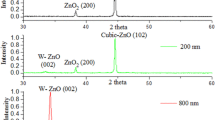Abstract—At present, atomic layer deposition and magnetron sputtering processes are used in the production of integrated circuits (IC) to obtain structures with nanometer layer thicknesses and sharp interfaces between them. However, there are also ion-beam and reactive ion-beam deposition processes, which are mainly used to produce multilayer optical coatings. The aim of this work is to study the possibility of obtaining structures with nanometer layer thicknesses and sharp interfaces between them in the processes of ion-beam and reactive ion-beam deposition. The studies were carried out by time-of-flight secondary ion mass spectrometry (SIMS) and spectral ellipsometry methods. Study of the structure Ta (3 nm)/Nb (3 nm)/Ta (3 nm) reveals that ion-beam deposition can form structures with nanometer layer thicknesses and sharp boundaries between them. On the other hand, in reactive ion-beam deposition of the structure Nb (3 nm)/Ta2O5 (3 nm)/Nb (3 nm), oxidation occurs on the entire thickness of the metal layer following the metal oxide layer due to ions, atoms, and molecules of oxygen contained in the ion beam.



Similar content being viewed by others
REFERENCES
V. Yu. Kireev, Nanotechnology in Microelectronics. Nanolithography - Processes and Equipment (Intellekt, Dolgoprudnyi, 2016) [in Russian].
International Roadmap for Device and Systems (IRDS), 2017 Ed., Executive Summary (Inst. Electric. Electron. Eng. (IEEE), 2017).
AMD Navi GPU is Based on 7 nm Process. https://fudzilla.com/news/graphics/43677-amd-navi-gpu-is-based-on-7nm-process.
Design Norms in Microelectronics. www.nanonewsnet.ru/articles/2018/proektnye-normy-v-mikroelektronike-gde-na-samom-dele-7-nanometrov-v-tekhnologii-7nm. Accessed Sept. 24, 2018.
J. Robertson, “High dielectric constant gate oxides for metal gate Si transistors,” Rep. Prog. Phys. 69, 327 (2006). https://doi.org/10.1088/0034-4885/69/2/R02
D. G. Gromov, A. I. Mochalov, A. D. Sulimin, and V. I. Shevyakov, Ultra-Large Integrated Circuit Metallization (BINOM, Moscow, 2012) [in Russian].
R. J. Martín-Palma, F. Agullo-Rueda, and J. Martínes-Duart, Nanotechnology for Microelectronics and Optoelectronics (Elsevier, Amsterdam, 2006; Tekhnosfera, Moscow, 2009).
UMC and Avalanche Technology Partner for MRAM Development and 28nm Production. https://electroiq.com/2018/08/umc-and-avalanche-technology-partner-for-mram-development-and-28nm-production.
Atomic Layer Deposition for Semiconductors, Ed. by Ch. S. Hwang and Ch. Y. Yoo (Springer Science, New York, 2014).
A. L. Aseev, “Nanomaterials and nanotechnologies for modern semiconductor electronics,” Ross. Nanotekhnol. 1 (1–2), 97 (2006).
B. S. Danilin, Application of Low-Temperature Plasma for Supplying Thin Films (Energoatomizdat, Moscow, 1989) [in Russian].
E. V. Berlin and L. A. Seidman, Production of Thin Films by Reactive Magnetron Sputtering (Tekhnosfera, Moscow, 2014) [in Russian].
H. Sato, M. Yamanouchi, S. Ikeda, et al., “MgO/CoFeB/Ta/CoFeB/MgO recording structure in magnetic tunnel junctions with perpendicular easy axis,” IEEE Trans. Magn. 49, 4437 (2013). https://doi.org/10.1109/tmag.2013.2251326
Handbook of Semiconductor Interconnection Technology, Ed. by G. C. Schwartz and K. V. Srikrishnan, 2nd ed. (CRC, Taylor Francis Group, New York, 2006).
Aspira 150. www.izovac.com.
P. van der Heide, Secondary Ion Mass Spectrometry: An Introduction to Principles and Practices (Wiley, New Jersey, 2014).
TOF.SIMS 5 - 100 brochure. www.iontof.com.
V. A. Shvets, E. V. Spesivtsev, S. V. Rykhlitskii, and N. N. Mikhailov, “Ellipsometry as a high-precision technique for subnanometer-resolved monitoring of thin-film structures,” Nanotechnol. Russ. 4, 201 (2009).
MVU TM-Magna 150. www.niitm.ru.
A. A. Dedkova, V. Yu. Kireev, and N. S. Mazurkin, “Analysis of the parameters of the ferromagnetic films by means of the system for research of the magneto-optical effect of Kerr and a spectral ellipsometer,” Nano- Mikrosist. Tekh. 20, 521 (2018). https://doi.org/10.17587/nmst.20.521-527
Funding
The study was carried out with equipment of the Shared Research Center “Microsystem Technology and Electronic Component Base” of MIET with the support of the Russian Ministry of Science and Higher Education as part of contract no. 14.578.21.0250 (UN RFMEFI57817X0250).
Author information
Authors and Affiliations
Corresponding author
Ethics declarations
The authors declare that they have no conflict of interest.
Rights and permissions
About this article
Cite this article
Dedkova, A.A., Kireev, V.Y., Myslivets, A.S. et al. Research of the Possibility to Obtain Structures with Nanometer Layer Thicknesses and Sharp-Cut Interfaces between Them Using Ion-Beam and Reactive Ion-Beam Deposition Processes. Nanotechnol Russia 14, 234–239 (2019). https://doi.org/10.1134/S1995078019030042
Received:
Revised:
Accepted:
Published:
Issue Date:
DOI: https://doi.org/10.1134/S1995078019030042




